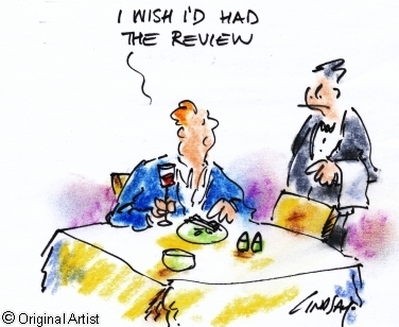0 Comments
 The perfect critic. The perfect critic. Once, I heard a dance critic try (at least partially) to legitimize their practice by saying, “I see every show…” Though I do respect this critic, it certainly is not because they supposedly see every show. The statement is (though probably not consciously) obviously a lie. At best, by this the critic might mean two things: one, they see the shows that most fall under the heading of contemporary dance; two, they see the shows that most fall under the heading of professional shows. This critic can (at least partially) get away with this statement because it is foreseeable that someone could see almost every dance show performed in Montreal. However, when we transfer this argument to other art forms, it quickly falls to pieces. Imagine a film/music/book critic making the same statement. It would be laughable. Yet film/music/book criticism should obviously not be discredited simply by virtue that it is impossible for a critic to consume all that is released within their field. All this to say what should be obvious: that mass consumption does not legitimize a critic’s practice. So what does then? What is a critic? First it might be useful to ascertain what a critic isn’t. 1. As has already been established, a critic is not (necessarily) a mass consumer. Seeing a lot of movies does not make one a critic; it makes one a cinephile (at worst, and an experience-seeker at best). 2. A critic is not someone with good taste. The best thing I can say in regards to this point is go ahead and read the countless critics out there who visibly have good taste; then notice that your sole interest in their reviews is that you tend to agree with them. Your interest then is not in their criticism, but in your narcissism. 3. A critic is not an advertiser. To say that an album is “the best of the year” is to do nothing more than to encourage consumption in a way that requires no thought whatsoever. It is a readymade sentence that means nothing more than “you should listen to this by virtue that I think you should listen to this.” 4. A critic should not love their field unconditionally. When I go to a reading, I inevitably think, “Have writers never gone to any other kind of art performance in their life? This is unacceptable.” If there is no fence between different art forms, they can all be compared. If there is a fence between the arts, we need to be aware of how these fences affect what is produced within them. In other words, a dance critic should not be concerned with seeing every dance show performed in any given city, but with listening to all of the music being produced. It will make them a better dance critic. So, in less negative terms, what is a critic then? 5. A critic is a thinker. Though their encounter with the work of art first occurs at the level of perception and may primarily result in affect, it is thought that will enable the critic to translate their experience into words. 6. A critic must meditate. Because some works of art work on that level. A critic must do cocaine. Because some works of art work on that level. Extrapolate to include all human and non-human experiences. 7. A critic contextualizes. No artwork is produced in isolation. No artwork, no matter how personal, is produced outside of culture. Every artwork is produced either in accordance with the dominant culture or in opposition to it. Every artwork is a form of oppression or of liberation. 8. That is to say that a critic politicizes, or rather brings to light the politics that are inherent in any work of art. Otherwise art is meaningless. Otherwise criticism is meaningless. 9. A critic is someone who makes links with other works within their discipline, but also with works outside of it. A comparison between two artworks is not more meaningful simply by virtue that they use the same medium. I reiterate: a dance critic needs to be a music critic. 10. A critic needs to be aware that an artistic experience is necessarily a personal (and cultural) experience. Therefore, a critic must strive to be as aware as possible of how their race, gender, social class, and sexual orientation affect their perception of the work of art. A critic must not deny these facts. In other words, a critic must be as subjective as possible. A personal experience is not a unique experience. 11. A critic is a writer. This point cannot be emphasized enough. Though criticism is about a work of art, it must be able to live independently of it. If anything, this is the mark of good criticism. In other words, readers should be able to identify whether criticism is good without having experienced the work of art that said criticism is about. Criticism is an experience in and of itself. 12. A critic must not ask whether a work of art is good. The answer to this question is a simple yes or no, which requires no thinking or writing. A critic must not ask what the artist is trying to achieve. The artist is better equipped to answer that question (should they wish to). A critic must ask, “What does the work of art do?”  Cartoon by Lindsay Foyle 1. The only reader who cares whether you like an artwork is one who has the exact same taste as you. In other words, no one cares if you like an artwork or not. 2. One of the most overrated qualities in a critic is good taste. It is often a limited and limiting concept that ends up discrediting a lot of artworks that refuse to play by bourgeois or hipster rules. Art does not need to be well made so much as it needs to make well. 3. Avoid any sentence that might be quoted for publicity purposes. Criticism is not advertising, nor is it public relations. 4. Avoid empty rhetorical words such as “good/better/best,” “bad/worse/worst,” and their synonyms. Instead, use words such as “regressive/progressive”, “sexist/feminist”, “racist/anti-racist,” “homophobic/transphobic/queer-positive,” etc. These words carry weight, as they actually mean something. 5. The role of the critic is not to tell readers what is worth their time and money. Criticism is not consumerism. The role of the critic, much like that of the artist, is to create meaning. The critic should not be an informed consumer, but an informed thinker. 6. It is indeed hard to see the forest for the trees, especially when it comes to newer artworks, but that is precisely and imperatively what the critic must do. The role of the critic is to contextualize, to argue why a work is significant or relevant, or not. 7. It is a mistake to believe that good criticism can only be about good artworks. Criticism is a form of thought, and the artwork is not doing the thinking for the critic. 8. Like (hopefully) the artists they review, critics should have political and artistic convictions. These produce meaning, which is what a critic should be seeking. 9. Turn your hate for works you despise for artistic reasons rather than political ones into admiration. These works will haunt you for much longer than the ones you merely like, and works that fail to be remembered also fail to create meaning. 10. Reward risks taken by artists, even if they ultimately fail. There is no point in rewarding those who play it safe and simply copy the success of their predecessors. 11. Do not emulate the style of critics who put out generic reviews for mainstream publications. There is no point in putting out a review that could have been produced just as well by another writer with no personality. If you are replaceable, you will be replaced.  When men talk fast, it's genius. “Critiquing is a lot of things,” recently wrote La Presse columnist Pierre Foglia, “but … it’s first an act of resistance. Resistance to trends, to taking the easy way out, to ideologies, to patronizing lectures, to one’s environment, to advertising.” If this is indeed what critiquing is, then popular criticism is all but dead. Though reviews appear in greater numbers than ever before thanks to the internet, the quality of said reviews is often just as low as the works they seek to discuss. In an interview with fellow critic Todd McCarthy, Roger Ebert said that the standard of film criticism is now “Better, because of the internet. This is a golden age of film criticism, although it no longer is a paying job. There are no length restrictions. Writing can be more esoteric or expert.” Though I agree with his basic premise, the average review I read on the internet gives me trouble in sharing his optimism. Helen Faradji of Québec cinema magazine 24 images is as skeptical as I am, noting the “deplorable return of the pithy judgment that can often be resumed to a sad ‘like it, don’t like it’.” There must undoubtedly be a good deal of quality reviews on the internet, but being able to find them is another story. As a foodie friend of mine once recommended, “If you want to find a good restaurant, go somewhere where the menu only has a few items. Sure, the place with the large menu might have some good dishes, but how are you going to find them amidst all the rest?” The same could be said of reviews on the internet. The lack of editors preventing the worst of writing from ever reaching human eyes means that most of what can be found online is nothing more than internet pollution. Yet print has little more to offer. Since it is impossible to escape the dominant culture, the role of popular criticism has been clearly assigned by it. It is just one more wheel in the machine of consumption. The consumer world is seen as overwhelming – too many books, too many movies, too much music – and, at worst, the role of the critic has become to help consumers navigate this world, to tell them what is worth their time and money. However, as Kaija Pepper writes in “Diving into Dance: A Critic’s Manifesto,” “The work of art should not be regarded ‘as simply another phenomenon and product in a world already crowded with them’, and it is the critic’s job to pursue the depth beneath the surface.” French philosopher Jacques Rancière also views criticism as a way to deepen, to extend the work of art into a continuous but alternative mindspace: “For me, film criticism is not a way of explaining or classifying things, it’s a way of prolonging them, making them resonate differently.” Unfortunately, such lofty aspirations are often left unfulfilled. At best, the contemporary critic is a tastemaker. And since, raised in the age of readily accessible media, keeners with good taste are a dime a dozen, newspapers can easily replace them by someone just as easily “qualified” (meaning nothing more than someone whose taste is just as good) for just that price. Gone are the days when film critic Jonas Mekas would push avant-garde cinema in his column in the Village Voice. Of course, that was in the 1960s, a much more political time. Today, it is impossible to tell the artistic and political convictions of most critics by reading their reviews. Hence the death of anything that is of value in popular criticism. Nowhere does this become more apparent than on websites that attempt to summarize the opinion of critics, the most popular being Metacritic. Given that the critic as consumption adviser is now the norm, Metacritic indeed bares its name well. There are now so many critics with contrasting views (“Who to believe??”) that we need websites to help us navigate through them, to read all of them by reading none of them. To offer a metareview is to effectively get rid of what little discourse there already is. Movies are no longer loved by some and hated by others; rather, they have merely received a lukewarm critical reception. The most critically acclaimed film of last year, according to Metacritic calculations, is The Social Network. Of course, the biggest feat of the movie about Facebook founder Mark Zuckerberg is just that: it deals with a currently popular subject matter. With its fast-paced dialogue, the first half of the film plays like a good episode of Gilmore Girls; the second, like a bad one. However, The Social Network does have a lot of testosterone, which made it easier for critics and audiences to elevate it above Gilmore Girls. Otherwise, The Social Network suffered from what has become David Fincher’s usual uninspired directing. It still managed to score 95 (out of 100) on Metacritic. On the other hand, Gaspar Noé’s Enter the Void, quite possibly the only feature-length fiction film that truly mattered on an artistic level in 2010, barely managed to score 69. Arguably, Noé’s 161-minute drug-like cinematic trip is not as easily likeable as The Social Network. And that’s precisely the point; as long as critics judge artworks by how much they “like” them – as though artworks were nothing more than a Facebook status – they will fail to reward risks taken by artists. As Jonathan Rosenbaum notes in “They Drive by Night: The Criticism of Manny Farber,” when asked what the role of evaluation was in his critical work, Farber replied, “It’s practically worthless for a critic. The last thing I want to know is whether you like it or not; the problems of writing are after that. I don’t think it has any importance; it’s one of those derelict appendages of criticism. Criticism has nothing to do with hierarchies.” If as I am hinting there is indeed a link between familiarity and likeability, maybe the movie most revealing of the times to come out last year was Banksy’s pseudo-documentary Exit Through the Gift Shop. In it, a graffiti artist groupie named Thierry Guetta decides to become a big name in the art world himself by creating, in the loosest sense of the term, works of art that are mere pastiche of pop art. His first solo exhibit is a success because the artworks are readily recognizable by those attending the vernissage. “I know this is art,” they seem to tell themselves, “because it looks like art I’ve already seen.” Even in art, it is familiarity that appeals to most. If in this manner critics are no different than the public at large, they have no reason for being. Their job should not be to preemptively tell us whether we would like an artwork, but indeed to “pursue the depth beneath the surface.”
Metacritic (and hence the most read popular critics) also fails to go beneath the surface when it comes to music. The highest rated release of 2010? Kanye West’s My Beautiful Dark Twisted Fantasy, with a score of 94. Apparently, all you have to do to be exposed to the most innovative music being made today is listen to Top 40 radio. This also reveals that, if a pop record is only half bad, people are so pleasantly surprised that they will elevate it to the status of masterpiece. Given my negative outlook on popular criticism, one might be tempted to ask if there are any contemporary critics whose writing I do admire. In the vast polluted ocean of the internet, I have stumbled upon a few, sometimes in the most unlikely places. Some of the users on rateyourmusic.com often surprise me with their ability to perfectly capture a movie’s underlying themes in a most concise and witty manner. The Stranger’s Lindy West has turned her ability to see through Hollywood sexist bullshit into a hilarious trademark. Many of the writers at thisrecording.com have tackled 90s movies, such as The Hot Spot and Wild Things, in surprisingly insightful ways. Maybe twenty years are indeed needed to gain enough distance to see artworks more clearly. After a certain period of time, whether an artwork is “good” or “bad” ceases to matter. Perhaps we should focus our reviews on older works. It would certainly be a way of avoiding criticism that reads more like advertising. Again, Pepper argues that “a critic is neither a publicist nor the artist’s champion and, like any audience member, must enter into and discover the work on independent terms. Donald Kuspit in ‘Art Criticism: Where’s the Depth?’ (in The Critic is Artist: The Intentionality of Art (1984)), writes that art can only be significant if it is shown to connect beyond its appearance, and beyond what the artist might say about it, to the deeper world view and consciousness that it represents.” With regime overthrows in the Middle East and the Occupy Movements in North America, it does seem like maybe once again the times are a-changin’. As people politicize themselves, we can only hope that they will also ask to no longer be seen as mere consumers, but as thinking subjects in the artistic landscape, and that popular criticism will reflect these new attitudes. |
Sylvain Verstricht
has an MA in Film Studies and works in contemporary dance. His fiction has appeared in Headlight Anthology, Cactus Heart, and Birkensnake. Archives
October 2023
Categories
All
|

 RSS Feed
RSS Feed